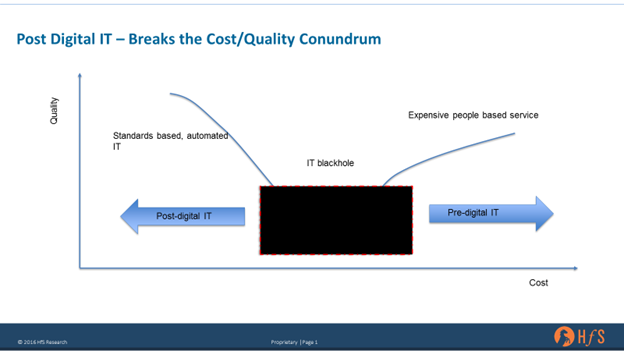
For as long as the IT services world has existed, we’ve had to balance cost, quality, and speed of delivery to make it financially viable. The old adage being we offer 3 kinds of services good, cheap and fast, but you can only pick 2:
- Fast & good won’t be cheap.
- Good & cheap won’t be fast.
- Cheap & fast won’t be good.
Will the cloud and As-a-Service delivery mean that the post-digital world will be free of this constraint?
Digital is the new normal, not the shiny new thing
Before we look at this question, it’s probably worth explaining what we mean by “post-digital.” When we say post-digital, we do expect eyes to roll and people to shout that they are still very much in digital transformation mode. When we talk about post-digital, we are talking about digital as a separate undertaking from business as usual. One of the key findings of our recent survey work and the driving force behind our OneOffice paradigm is that digital technologies are now well established and are already providing the catalyst to drive ambitious organizations to embed them into their business operations. This is especially the case in customer-centric industries where business strategy is aligned to customer requirements with the digital connection to the customer as the feedback loop. In the post-digital world, digital is no longer “disruptive,” it is an established concept, it is the norm, and digital strategy is a major component of overall business strategy. At HfS, we believe we are rapidly getting to that point. It doesn’t mean there won’t be legacy processes and challenges, but the using the term digital will be unnecessary.
So back to the question of balancing the cost and quality of services. HfS has looked at the thorny topic of cost versus quality a number of times, particularly in relation to IT infrastructure services. We published our view on the type of IT required for the As-a-Service Economy earlier this year – “Can Do” IT” Underpins The As-a-Service Economy, where we talked about the importance of attitude, when you can’t have all three of the good, cheap, fast Holy Grail together.
IT professionals must become problem solvers in the post-digital world
The post-digital IT world needs to break out from this constraint. As automation and standardization are applied to a service, the cost should plummet, and the quality of the underlying service should improve – and until cognitive computing starts to function effectively, you really won’t get a highly personalized service. But you will get a good, cheap and fast one. You just won’t get a butler bringing it to you on a golden pillow.
The diagram below visualizes the relationship we see between cost and quality in the traditional IT and post digital worlds.

The chart is conceptual, showing how not only the costs but also the quality of a people-based process should improve with standardization and automation. The costs get driven down as the service improves – fewer problems, more stable and less need for expensive people. The right side of the graph although driven somewhat by good process relies on better and more staff to solve the IT problem without addressing the complexity of the underlying architecture. Essentially, quality should be more or less proportional to the money spent in the old world. With platform based IT the relationship to cost is more complicated – the quality gets better as the service is more standardized and more automated – so the cost should decrease as well. Additional spending in the post-digital world should get you more functionality, not higher quality.
By the way, the chart isn’t supposed to be taken literally, as the real world costs and quality equation is a lot more complicated than this linear chart. There are lots of companies that are paying an awful lot of money for very poor IT in the traditional model – so the relationship isn’t always like this. This is also a point worth making about more process driven automated services – the quality and outcomes are much more predictable and are likely to better fit this model – at least in this idealized situation.
The Bottom Line: The more standardized IT becomes, the more the onus moves to IT staff aligning IT to the business as opposed to keeping the IT lights on
This won’t necessarily make all IT cheaper, but areas which can be standardized and automated will become platforms for expensive staff to create value for organizations rather than spending their time fighting fires and remedial responses to structural issues. This model for IT frees up cost to spend on more functionality and creative solutions for clients.
But baseline IT and IT services – the keep the lights on services – should be fast, cheap and good, all at the same time. Just don’t expect them to be served on a golden pillow. This is where the real challenge for IT starts, as the IT department needs to become one of the main brokers of capability for the organization – focusing its effort on creating value for the business not ensuring SLAs are met.
Posted in : IT Outsourcing / IT Services






